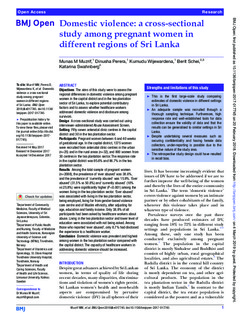| dc.contributor.author | Muzrif, Munas M. | |
| dc.contributor.author | Perera, Dinusha Chamanie | |
| dc.contributor.author | Wijewardena, Kumudu | |
| dc.contributor.author | Schei, Berit | |
| dc.contributor.author | Swahnberg, Katarina | |
| dc.date.accessioned | 2019-03-12T09:12:34Z | |
| dc.date.available | 2019-03-12T09:12:34Z | |
| dc.date.created | 2018-10-10T17:36:08Z | |
| dc.date.issued | 2018 | |
| dc.identifier.citation | BMJ Open. 2018, 8:e017745 (2), 1-8. | nb_NO |
| dc.identifier.issn | 2044-6055 | |
| dc.identifier.uri | http://hdl.handle.net/11250/2589655 | |
| dc.description.abstract | Objectives
The aims of this study were to assess the regional differences in domestic violence among pregnant women in the capital district and in the tea plantation sector of Sri Lanka, to explore potential contributory factors and to assess whether healthcare workers addressed domestic violence and disclosure among survivors.
Design
A cross-sectional study was carried out using interviewer-administered Abuse Assessment Screen.
Setting Fifty-seven antenatal clinic centres in the capital district and 30 in the tea plantation sector.
Participants
Pregnant women between 6 and 40 weeks of gestational age. In the capital district, 1375 women were recruited from antenatal clinic centres in the urban (n=25) and in the rural areas (n=32), and 800 women from 30 centres in the tea plantation sector. The response rate in the capital district was 95.6% and 96.7% in the tea plantation sector.
Results
Among the total sample of pregnant women (n=2088), the prevalence of ‘ever abused’ was 38.6%, and the prevalence of ‘currently abused’ was 15.9%. ‘Ever abused’ (31.5% vs 50.8%) and ‘currently abused’ (10% vs 25.8%) were significantly higher (P<0.001) among the women living in the tea plantation sector. ‘Ever abused’ was associated with living in the tea plantation sector, being employed, living far from gender-based violence care centre and of Muslim ethnicity, after adjusting for age, education and family income. Only 38.8% of all participants had been asked by healthcare workers about abuse. Living in the tea plantation sector and lower level of education were associated with not being asked. Among those who reported ‘ever abused’, only 8.7% had disclosed the experience to a healthcare worker.
Conclusion
Domestic violence was prevalent and highest among women in the tea plantation sector compared with the capital district. The capacity of healthcare workers in addressing domestic violence should be increased. | nb_NO |
| dc.language.iso | eng | nb_NO |
| dc.publisher | BMJ Publishing | nb_NO |
| dc.rights | Navngivelse-Ikkekommersiell 4.0 Internasjonal | * |
| dc.rights.uri | http://creativecommons.org/licenses/by-nc/4.0/deed.no | * |
| dc.title | Domestic violence: a cross-sectional study among pregnant women in different regions of Sri Lanka | nb_NO |
| dc.type | Journal article | nb_NO |
| dc.type | Peer reviewed | nb_NO |
| dc.description.version | publishedVersion | nb_NO |
| dc.source.pagenumber | 1-8 | nb_NO |
| dc.source.volume | 8:e017745 | nb_NO |
| dc.source.journal | BMJ Open | nb_NO |
| dc.source.issue | 2 | nb_NO |
| dc.identifier.doi | 10.1136/bmjopen-2017-017745 | |
| dc.identifier.cristin | 1619473 | |
| dc.relation.project | Norges forskningsråd: 220893 | nb_NO |
| dc.description.localcode | © Article author(s) (or their employer(s) unless otherwise stated in the text of the article) 2018. All rights reserved. No commercial use is permitted unless otherwise expressly granted. This is an Open Access article distributed in accordance with the Creative Commons Attribution Non Commercial (CC BY-NC 4.0) license, which permits others to distribute, remix, adapt, build upon this work non-commercially, and license their derivative works on different terms, provided the original work is properly cited and the use is non-commercial. See: http://creativecommons.org/licenses/by-nc/4.0/ | nb_NO |
| cristin.unitcode | 194,65,20,0 | |
| cristin.unitname | Institutt for samfunnsmedisin og sykepleie | |
| cristin.ispublished | true | |
| cristin.fulltext | original | |
| cristin.qualitycode | 1 | |

